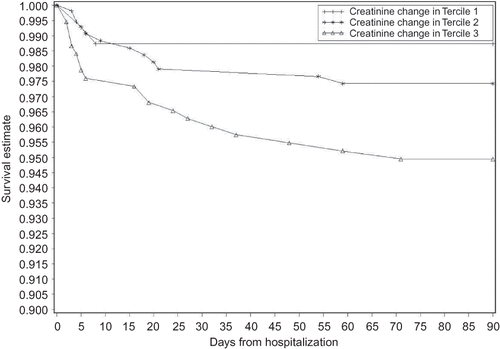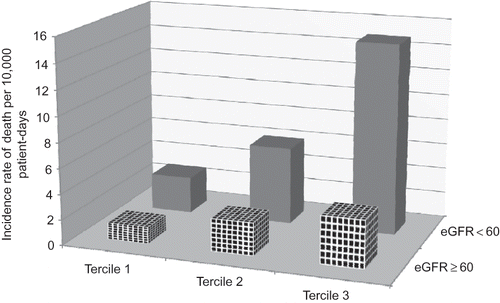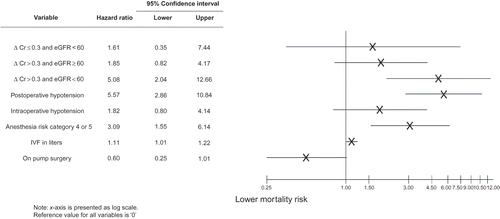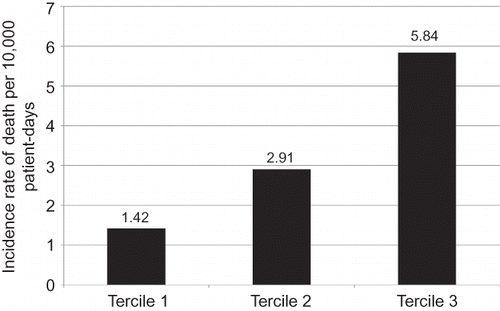Abstract
Background: A small increase in serum creatinine after cardiac surgery has been associated with increased mortality. However, it is unclear whether this association varies with baseline renal function. Methods: We retrospectively reviewed data on 1359 patients who underwent cardiac surgery over a 4-year period in two tertiary care hospitals including demographic data, comorbid conditions, and intra- and postoperative complications using a standardized form. We followed patients for 90 days postoperatively and death rates and length of hospital stay were noted. Results: The incidence of acute kidney injury (AKI) after cardiac surgery was 40.2%. Patients were grouped into terciles based on change in serum creatinine. Kaplan–Meier survival analysis and Cox regression analysis showed that the development of AKI with a small increase in serum creatinine of more than 0.3 mg/dL from baseline (tercile 3) was associated with a higher risk of mortality within 90 days and 7 days longer hospitalization following a cardiac surgery. Stratified analysis showed that only patients with baseline eGFR < 60 mL/min/1.73 mCitation had fivefold higher mortality with rise of serum creatinine >0.3 mg/dL. Conclusions: Patients with baseline eGFR < 60 mL/min/1.73 m2 had increased risk of mortality after cardiac surgery with a small increase in serum creatinine whereas a similar increase in serum creatinine in those with eGFR ≥ 60 mL/min/1.73 m2 did not increase mortality.
INTRODUCTION
Acute kidney injury (AKI) develops in 5–42% of the patients who undergo cardiac surgery depending on the definition of AKI, and approximately 1% of patients require dialysis.Citation1–6 Development of AKI has been shown to be associated with increased length of hospitalization and mortality in several settings including cardiac surgery. Development of AKI requiring dialysis after cardiac surgery is associated with an increased incidence of infection, length of critical care unit stay, and in-hospital death.Citation7–9 Chertow et al. have shown that AKI requiring dialysis is an independent risk factor for mortality following cardiac surgery.Citation10 Recent studies have shown that even small increases in serum creatinine postoperatively are associated with increased mortality.Citation11
The presence of stage 3 chronic kidney disease (CKD) at baseline (GFR < 60 mL/min/1.73 m2) has been shown to be associated with increased risk of postoperative AKI, longer hospital stay, increased hospital mortality, and poorer long-term outcome.Citation12,Citation13 Mild renal dysfunction after cardiac surgery is associated with increased mortality.Citation8,Citation11,Citation14 However, it is unclear whether this association varies with baseline renal function. We studied the effect of a small increase in postoperative serum creatinine on 90-day mortality and hospital stay in patients with normal baseline eGFR.
METHODS
The study population was drawn from patients who underwent cardiac surgery at two tertiary care hospitals affiliated with State University of New York (SUNY) at Buffalo: Buffalo Veterans Administration Medical Center (VAMC) and Erie County Medical Center (ECMC). A list of patients who had undergone surgery between 1 January 2001 and 31 December 2005 was generated through the hospital record system. This research protocol was approved by the Buffalo VAMC and SUNY at Buffalo Institutional Review Boards.
Clinical data were collected using a standardized form. Baseline demographic data (age, gender, race, weight, height, BMI, and smoking history) were collected. Comorbid conditions including congestive heart failure (shortness of breath or weakness with concomitant decreased ejection fraction (<50%) on two-dimensional echocardiography) and American Society of Anesthesiologists (ASA) category were noted. Intraoperative data collection included the duration of clamp, blood pressure, use of vasopressors, intravenous fluids (IVF), and urine output. Postoperatively serial serum creatinine levels, blood pressure, IVF, urine output, use of vasopressors, and dialysis requirement were recorded.
Definitions
Acute kidney injury (AKI) was defined using the AKIN (Acute Kidney Injury Network) criteria: stage 1 – increase in serum creatinine of ≥0.3 mg/dL or an increase of 50–200% from baseline; stage 2 – increase in serum creatinine of 200–300%; and stage 3 – increase in serum creatinine of >300% or serum creatinine level >4 mg/dL.
Race was categorized as Caucasian, African American, or other. Type of surgery was defined as elective or emergency as per surgical attending note. Anesthesia risk was determined from preoperative anesthesia records and stratified into five categories: ASA 1 was defined as a healthy individual; ASA 2 – patient with mild systemic disease; ASA 3 – patient with severe systemic disease; ASA 4 – patient with severe systemic disease with constant threat to life; and ASA 5 – moribund patient who is not expected to survive without surgery.
Patients were followed for 90 days from the day of surgery and numbers of death were noted. Length of hospital stay was calculated as the total number of days from surgery to discharge.
Statistical method
Patients were grouped into terciles based on change in creatinine (difference between peak and baseline). Tercile cutoff points are 0.1 and 0.3. Since there are a number of patients with creatinine change equal to 0.1 or 0.3, patients with creatinine change of 0.1 were all included in tercile 1. Similarly all patients with a creatinine change of 0.3 were included in tercile 2. This has resulted in an unequal distribution of patients in the three terciles (T1: ΔCr ≤ 0.1 (n = 554); T2: ΔCr >0.1 to ≤0.3 (n = 429); T3: ΔCr >0.3 (n = 376)).
Incidence rates per 10,000 patient-days in each creatinine change tercile as well as for baseline eGFR below and above 60 mL/min/1.73 m2 were calculated from patient-days and number of deaths. Kaplan–Meier estimates and survival function for mortality within 90 days of surgery were created by creatinine change tercile stratum. Homogeneity of survival curve was calculated by log-rank test. Unadjusted and adjusted (for demographics, anesthesia risk category ≥ 4, intra- and postoperative risk factors, and congestive heart failure) hazard ratios were obtained from Cox model.
Baseline eGFR was calculated by modification of diet in renal disease (MDRD) equation as below:
Baseline eGFR was categorized into ≥60 and those <60 and this categorical variable was included in the adjusted Cox model. Finally, to study the interaction between baseline eGFR and serum creatinine change, patients were stratified as serum creatinine change ≤ 0.3 and eGFR ≥60; serum creatinine change ≤0.3 and eGFR < 60; serum creatinine change >0.3 and eGFR ≥ 60; serum creatinine change >0.3 and eGFR < 60. The last three were included in the Cox model with the first one acting as the base category.
A Tobit model was used to estimate the effect of creatinine change tercile on the length of hospital stay after controlling for coronary artery bypass graft (CABG), hypotension during intra- and postoperative period, and urine output in liter during operation. A Tobit model was used because length of hospital stay is censored both below zero and above a certain positive value. That is, length of stay cannot take either non-positive values or very large positive values.
SAS 9.1.3 was used to estimate the Kaplan–Meier (KM) survival function and the Cox models. The Tobit model was estimated using Stata/SE 10.0.
RESULTS
A total of 1359 patients over the age of 18 years who underwent cardiac surgery at two major hospitals in western New York between 1 January 2001 and 31 December 2005 were the subjects of the study. The mean baseline serum creatinine was 0.96 (±0.21) mg/dL and the majority of the surgery was CABG alone (87.05%) and done electively (91.02%) with cardiopulmonary bypass pump (69.23%). The mean use of IVF during surgery was 3907 (±2121) mL and 44.6% developed hypotension during operation and 13.1% developed hypotension postoperatively. The mean length of hospital stay of all patients was 8.38 (±10.39) days.
The distribution of demographic variables, comorbidities, and intra- and postoperative risk factors across the creatinine change terciles are shown in . Age, baseline serum creatinine, and higher amount of IVF were significantly higher across the creatinine change terciles 1–3. Differences were noted across all groups with respect to diabetes, hypertension, congestive heart failure (CHF), chronic obstructive pulmonary disease (COPD), anesthesia risk category (≥4), type of surgery, on pump surgery, and hypotension during the intra- and postoperative period.
Table 1. Frequency distribution and univariate statistics of variables by creatinine change tercile
Thirty-seven patients died within 90 days of surgery. The incidence of death per 10,000 patient-days was 1.42, 2.91, and 5.84% in creatinine change terciles 1–3, respectively (). Univariate analysis showed that an increase in serum creatinine of more than 0.3 mg/dL from baseline (tercile 3) was significantly associated with increased risk of 90-day mortality (p = 0.002) (). We analyzed the incidence of death per 10,000 patient-days by comparing relative increase in serum creatinine after surgery to their absolute preoperative baseline eGFR (above and below 60 mL/min/1.73 m2). The incidence of death per 10,000 patient-days was much higher in patient with baseline eGFR < 60 ().
Figure 2. Survival function for 90-day mortality by creatinine change tercile. Kaplan–Meier analysis showed that an increase in serum creatinine of more than 26 μmol/L from baseline (tercile 3) was significantly associated with higher 90-day mortality.

Figure 3. Incidence of death per 10,000 patient-days comparing relative increase in serum creatinine after surgery to their absolute preoperative baseline eGFR value. The incidence of death per 10,000 patient-days was much higher in patients with baseline eGFR < 60.

Univariate analysis showed that older age, CHF, high anesthesia risk category 4 and 5, hypotension during operation and postoperation, higher baseline serum creatinine, and higher amount of IVF use during operation were significantly associated with 90-day mortality (). Furthermore, the risk of death within 90 days of surgery was increased fourfold in creatinine change tercile 3 (ΔCr >0.3) compared with tercile 1 (ΔCr ≤ 0.1) on unadjusted Cox proportional hazard model (hazard ratio 4.06, 95% CI 1.71–9.67).
Table 2. Frequency distribution and univariate statistics of variables by 90-day mortality
Several adjusted Cox proportional hazard models were built and the effect of demographic variables, high anesthesia risk category 4 and 5, and intra- and postoperative risk factors were included. We found that even after adjusting for significant variables, postoperative increase in serum creatinine of more than 0.3 mg/dL from baseline remained an independent risk factor for 90-day mortality after cardiac surgery (). Interaction between baseline eGFR and creatinine change terciles showed that an increase in serum creatinine of more than 0.3 mg/dL in patients with baseline eGFR of <60 increased the rate of death up to fivefold at 90 days after the cardiac surgery (; ).
Table 3. Mortality within 90 days of surgery by creatinine change tercile
Table 4. Mortality within 90 days of surgery by interaction between eGFR category and creatinine change tercile
Figure 4. Mortality within 90 days of surgery by interaction between eGFR category and serum creatinine change category. HR adjusted with ASA risk and intra- and postoperative risk factors.

We analyzed the effect of increased serum creatinine from baseline (creatinine change terciles) on length of hospital stay by Tobit regression model. We found that increased serum creatinine of more than 0.3 mg/dL prolonged hospitalization by 7.09 days compared with tercile 1 (t = 7.09, CI 3.51–6.19, p < 0.001).
DISCUSSION
The incidence of AKI after cardiac surgery was 40.2%. Development of AKI with a small increase in serum creatinine of more than 0.3 mg/dL from baseline was associated with a four times higher hazard of mortality within 90 days and 7 days longer hospitalization following a cardiac surgery. Stratified analysis showed that only patients with baseline eGFR <60 mL/min/1.73 m2 had higher mortality with a rise of serum creatinine >0.3 mg/dL.
Our data are consistent with that of Lassnigg et al., who showed that an increase in serum creatinine of 0.5 mg/dL is associated with increased mortality after cardiac surgery. Lassnigg's analysis showed that even a minimal increase in serum creatinine increases early postoperative period mortality (30-day mortality); however, it does not have a significant effect on long-term mortality.Citation11 We found that a minimal increase in serum creatinine of more than 0.3 mg/dL still has a significant association with mortality even at 90 days after surgery. Lassnigg et al. included all patients with baseline serum creatinine of <4.0 mg/dL in his analysis and reconfirmed the results in a separate group of patients with baseline serum creatinine of less than 1.3 mg/dL.Citation11 Serum creatinine less than 1.3 mg/dL does not reflect normal renal function as many patients with baseline serum creatinine of less than 1.3 mg/dL may have baseline eGFR < 60 mL/min/1.73 m2. We stratified patients in four groups based on their baseline eGFR and increase in postoperative serum creatinine. We found that postoperative increase in serum creatinine of more than 0.3mg/dL was associated with increased 90-day mortality in patients with baseline stage 3 CKD. Although our data included more than 80% patients with baseline eGFR of ≥60, an increase in postoperative creatinine of more than 0.3 mg/dL did not show an increased hazard of 90-day mortality in these patients.
Our results are in contrast to those of Thakker et al., who studied the association between postoperative renal dysfunction and mortality, while adjusting for preoperative renal dysfunction in 31,677 patients undergoing cardiac surgery. Mortality rate was 5.9% among the patients who developed 30% or greater decline in postoperative GFR. They also found that a better preoperative GFR attenuated the effect of postoperative renal dysfunction on mortality. However, in this study acute renal failure was defined by changes in GFR not by conventional definitions of risk, injury, failure, loss, and end-stage kidney disease (RIFLE) or AKIN criteria. Furthermore, they used a logistic model as opposed to the Cox model used here. The time to event analysis accounts for censoring and varying time to death or censoring.Citation15
Brown et al. prospectively studied the effect of the relative rise in postoperative serum creatinine on 90-day mortality in 1391 patients undergoing CABG. Patients with large increases in serum creatinine (≥50% from baseline) had a 6.5-fold increase in 90-day mortality. However, in this study hazard ratios were only reported by adjusting for age and gender.Citation14 Though our study has a similar limitation of few events, we constructed several different models including variables of pre-, intra-, and postoperative risk factors for mortality and found that an absolute increase of serum creatinine of more than 0.3 mg/dL is an independent predictor of 90-day mortality. This study did not examine the modifying influence of baseline renal function on a clinically relevant postoperative renal dysfunction and overall mortality.
Recently, a definition of AKI has been proposed by the AKIN. It is an abrupt (within 48 hours) absolute increase in serum creatinine of ≥0.3 mg/dL (≥26.4 μmol/L), a percentage increase in serum creatinine of ≥50% (1.5-fold from baseline), or a reduction in urine output (documented oliguria of less than 0.5 mL/kg per hour for more than 6 hours).Citation16 The cut off of 0.3 mg/dL was chosen as evidence shows that this small increment in serum creatinine is associated with adverse short- and long-term outcomes.Citation11,Citation16–19 In our study, an increase of more than 0.3 mg/dL in serum creatinine was associated with increased mortality after cardiac surgery.
AKI has been associated with significantly increased mortality, length of stay, and higher costs across a broad spectrum of conditions. An increase in serum creatinine of ≥0.5 mg/dL was associated with a 6.5-fold (95% CI 5.0–8.5) increase in the odds of death, a 3.5-day increase in length of stay, and nearly $7500 in excess hospital costs in general hospital population.Citation17 A small change in serum creatinine (1.5 times the baseline – RIFLE-R) had a 2.2-fold greater mortality, 1.6-fold increase in length of ICU stay, and 1.6-fold increase in total postoperative costs compared to controls after cardiac surgery.Citation9 Our results also show that development of AKI is associated with a 7-day increase in hospital stay, and the associated increase in costs.
Our study has several important limitations. (1) The data were collected from two major hospitals in one region in the United States; therefore results may not be generalizable to the world population. (2) Data were collected retrospectively by three different investigators; however, the principal investigator trained all the physicians who collected data and checked five charts at random reviewed by each of the other investigators for accuracy. (3) Patients with AKI included all patients (including AKI stages 2 and 3). However, we re-estimated the last Cox model after deleting 11 patients who were in AKI stages 2 and 3. The hazard ratio for patients with serum creatinine change >0.3 mg/dL and baseline eGFR < 60 mL/min/1.73 m2 was 5.0 with CI 1.99–12.54 compared with patients with serum creatinine change of ≤0.3 and baseline eGFR ≥60 mL/min/1.73 m2. (4) Other confounders not recorded in the data collection might have caused this association.
Our study confirms the association of small increase in serum creatinine postoperatively with increased mortality among patients with baseline CKD. It does not show an association of a small increase in serum creatinine and mortality in patients with normal baseline kidney function. Awareness of the increased risk of cardiac surgery in patients with underlying kidney disease and prevention of even small declines in renal function in these patients may improve survival.
Declaration of interest: The authors report no conflicts of interest. The authors alone are responsible for the content and writing of the paper.
REFERENCES
- Andersson LG, Ekroth R, Bratteby LE, Hallhagen S, Wesslen O. Acute renal failure after coronary surgery – a study of incidence and risk factors in 2009 consecutive patients. Thorac Cardiovasc Surg. 1993;41(4):237–241.
- Conlon PJ, Stafford-Smith M, White WD, Newman M, King S, Wihn MP. Acute renal failure following cardiac surgery. Nephrol Dial Transplant. 1999;14(5):1158–1162.
- Mangano CM, Diamondstone LS, Ramsay JG, Aggarwal A, Herskowitz A, Mangano DT. Renal dysfunction after myocardial revascularization: Risk factors, adverse outcomes, and hospital resource utilization. The Multicenter Study of Perioperative Ischemia Research Group. Ann Intern Med. 1998; 128(3):194–203.
- Thakar CV, Liangos O, Yared JP, ARF after open-heart surgery: Influence of gender and race. Am J Kidney Dis. 2003;41(4):742–751.
- Ostermann ME, Taube D, Morgan CJ, Evans TW. Acute renal failure following cardiopulmonary bypass: A changing picture. Intensive Care Med. 2000;26(5):565–571.
- Rosner MH, Okusa MD. Acute kidney injury associated with cardiac surgery. Clin J Am Soc Nephrol. 2006;1(1):19–32.
- Thakar CV, Yared JP, Worley S, Cotman K, Paganini EP. Renal dysfunction and serious infections after open-heart surgery. Kidney Int. 2003;64(1):239–246.
- Ryckwaert F, Boccara G, Frappier JM, Colson PH. Incidence, risk factors, and prognosis of a moderate increase in plasma creatinine early after cardiac surgery. Crit Care Med. 2002;30(7): 1495–1498.
- Dasta JF, Kane-Gill SL, Durtschi AJ, Pathak DS, Kellum JA. Costs and outcomes of acute kidney injury (AKI) following cardiac surgery. Nephrol Dial Transplant. 2008;23(6):1970–1974.
- Chertow GM, Levy EM, Hammermeister KE, Grover F, Daley J. Independent association between acute renal failure and mortality following cardiac surgery. Am J Med. 1998; 104(4):343–348.
- Lassnigg A, Schmidlin D, Mouhieddine M, Minimal changes of serum creatinine predict prognosis in patients after cardiothoracic surgery: A prospective cohort study. J Am Soc Nephrol. 2004;15(6):1597–1605.
- Zakeri R, Freemantle N, Barnett V, Relation between mild renal dysfunction and outcomes after coronary artery bypass grafting. Circulation. 2005;112(9 Suppl):I270–I275.
- Mangos GJ, Brown MA, Chan WY, Horton D, Trew P, Whitworth JA. Acute renal failure following cardiac surgery: Incidence, outcomes and risk factors. Aust N Z J Med. 1995; 25(4):284–289.
- Brown JR, Cochran RP, Dacey LJ, Perioperative increases in serum creatinine are predictive of increased 90-day mortality after coronary artery bypass graft surgery. Circulation. 2006;114(1 Suppl):I409–I413.
- Thakar CV, Worley S, Arrigain S, Yared JP, Paganini EP. Influence of renal dysfunction on mortality after cardiac surgery: Modifying effect of preoperative renal function. Kidney Int. 2005;67(3):1112–1119.
- Mehta RL, Kellum JA, Shah SV, Acute Kidney Injury Network: Report of an initiative to improve outcomes in acute kidney injury. Crit Care. 2007;11(2):R31.
- Chertow GM, Burdick E, Honour M, Bonventre JV, Bates DW. Acute kidney injury, mortality, length of stay, and costs in hospitalized patients. J Am Soc Nephrol. 2005;16(11): 3365–3370.
- Levy MM, Macias WL, Vincent JL, Early changes in organ function predict eventual survival in severe sepsis. Crit Care Med. 2005;33(10):2194–2201.
- Praught ML, Shlipak MG. Are small changes in serum creatinine an important risk factor? Curr Opin Nephrol Hypertens. 2005;14(3):265–270.
